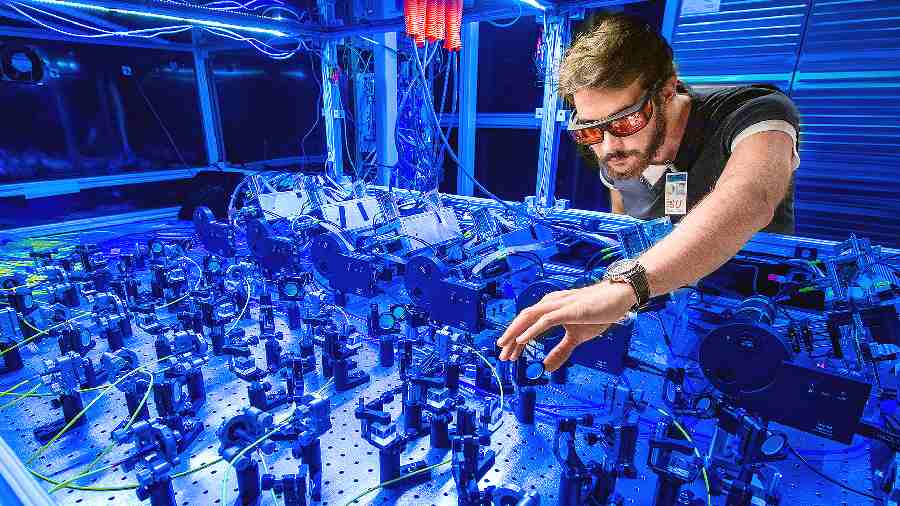After a three-year shut down for repairs and upgrades, the Large Hadron Collider has resumed shooting protons — the naked guts of hydrogen atoms — around its 17-mile electromagnetic underground racetrack. In early July, the collider will begin crashing these particles together to create sparks of primordial energy.
And so the great gameof hunting for the secret ofthe universe is about to beon again, amid new developmentsand the refreshedhopes of particle physicists.
A decade ago, Cern physicistsmade global headlineswith the discovery of theHiggs boson, a long-soughtparticle, which impartsmass to all the other particlesin the universe.
What is left to find? Almosteverything, optimisticphysicists say.
When the Cern colliderwas firstturned on in 2010,the universe was up forgrabs. The machine, thebiggest and most powerfulever built, was designed tofind the Higgs boson. Thatparticle is the keystone ofthe Standard Model, a setof equations that explainseverything scientists havebeen able to measure aboutthe subatomic world.
But there are deeperquestions about the universethat the StandardModel does not explain:where did the universe comefrom? Why is it made of matterrather than antimatter?What is the “dark matter”that suffuses the cosmos?How does the Higgs particleitself have mass?
Physicists hoped thatsome answers would materialisein 2010. Nothingshowed up except the Higgs.Frustratingly, the StandardModel remained unshaken.
The collider was shutdown at the end of 2018 forextensive upgrades and repairs.Among this set of upgradesare improvements tothe giant detectors that sitat the four points where theproton beams collide and analysethe collision debris.
Starting July, thosedetectors will have theirwork cut out for them. Theproton beams have beensqueezed to make themmore intense, increasingthe chances of protonscolliding at the crossingpoints — but creating confusionfor the detectors andcomputers in the form ofmultiple sprays of particlesthat need to be distinguishedfrom one another.
“Data’s going to be comingin at a much faster ratethan we’ve been used to,”said Mitesh Patel, a particlephysicist at Imperial CollegeLondon who conducts anexperiment at Cern. “Thatmakes our lives harder insome sense because we’vegot to be able to find thethings we’re interested inamongst all those differentinteractions. But it meansthere’s a bigger probabilityof seeing the thing you arelooking for,” he added.
Meanwhile, a varietyof experiments have revealedpossible cracks in theStandard Model — and havehinted at a broader, moreprofound theory of the universe.These results involverare behaviours of subatomicparticles whose names areunfamiliar to most of us inthe cosmic bleachers.
Take the muon, a subatomicparticle that becamebriefly famous last year.Muons are often referred toas fat electrons; they havethe same negative electricalcharge but are 207 timesas massive. Nobody knowswhere muons fit in the grandscheme of things.
Last year, a team of 200physicists associated withthe Fermi National AcceleratorLaboratory in Illinois,US, reported that muonsspinning in a magnetic fieldhad wobbled significantlyfaster than predicted by theStandard Model.
The discrepancy withtheoretical predictionscame in theeighth decimal place of thevalue of a parameter calledg-2, which described how theparticle responds to a magneticfield.
Scientists ascribed thefractional but real differenceto the quantum whisper ofas-yet-unknown particlesthat would materialise brieflyaround the muon andwould affect its properties.Confirming the existence ofthe particles would, at last,break the Standard Model.
The muon also figuresin another anomaly. Themain character, or perhapsvillain, in this drama is aparticle called a B quark,one of six varieties of quarkthat compose heavier particleslike protons and neutrons.Such quarks occur intwo-quark particles knownas B mesons. But thesequarks are unstable and areprone to fall apart in waysthat appear to violate theStandard Model.
Some rare decays of a Bquark involve a daisy chainof reactions, ending in a different,lighter kind of quarkand a pair of lightweightparticles called leptons,either electrons or theirplump cousins, muons. TheStandard Model holds thatelectrons and muons areequally likely to appear inthis reaction.
There is a third, heavierlepton called the tau, butit decays too fast to be observed.But Patel and hiscolleagues have found moreelectron pairs than muonpairs, violating a principlecalled lepton universality.
“This could be a StandardModel killer,” saidPatel, whose team has beeninvestigating the B quarkswith one of the LargeHadron Collider’s big detectors,LHCb. This anomaly,like the muon’s magneticanomaly, hints at an unknown“influencer” — aparticle or force interferingwith the reaction.
There is yet anotherparticle in this zoo behavingstrangely: theW boson, which conveys theso-called weak force responsiblefor radioactive decay.The mass of the W boson isconnected to the masses ofother particles, includingthe infamous Higgs. So thisnew discrepancy, if it holdsup, could be another crackin the Standard Model.
Still, all three anomaliesand theorists’ hopes for arevolution could evaporatewith more data. But to optimists,all three point in thesame encouraging directiontoward hidden particlesor forces interfering with“known” physics.
NYTNS











